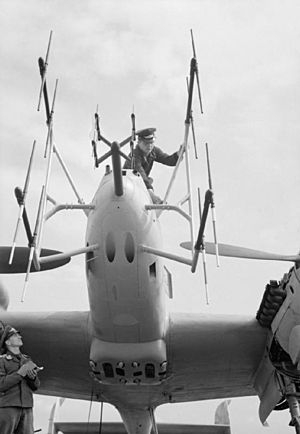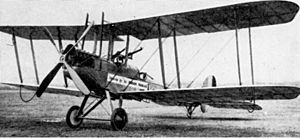All-weather fighter facts for kids

A night fighter (also known as all-weather fighter or all-weather interceptor for a period of time after the Second World War) is a fighter aircraft adapted for use at night or in other times of bad visibility. Night fighters began to be used in World War I and included types that were specifically modified to operate at night.
During the Second World War, night fighters were either purpose-built night fighter designs, or more commonly, heavy fighters or light bombers adapted for the mission, often employing radar or other systems for providing some sort of detection capability in low visibility. Many night fighters of the conflict also included instrument landing systems for landing at night, as turning on the runway lights made runways into an easy target for opposing intruders. Some experiments tested the use of day fighters on night missions, but these tended to work only under very favourable circumstances and were not widely successful.
Avionics systems were greatly miniaturised over time, allowing the addition of radar altimeter, terrain-following radar, improved instrument landing system, microwave landing system, Doppler weather radar, LORAN receivers, GEE, TACAN, inertial navigation system, GPS, and GNSS in aircraft. The addition of greatly improved landing and navigation equipment combined with radar led to the use of the term all-weather fighter or all-weather fighter attack, depending on the aircraft capabilities. The use of the term night fighter gradually faded away as a result of these improvements making the vast majority of fighters capable of night operation.
Early examples
At the start of the First World War, most combatants had little capability of flying at night, and little need to do so. The only targets that could be attacked with any possibility of being hit in limited visibility would be cities, an unthinkable target at the time. The general assumption of a quick war meant no need existed for strategic attacks.
Things changed on 22 September and 8 October 1914, when the Royal Naval Air Service bombed the production line and hangars of the Zeppelin facilities in Cologne and Düsseldorf. Although defences had been set up, all of them proved woefully inadequate. As early as 1915, a number of B.E.2c aircraft (the infamous "Fokker Fodder") were modified into the first night fighters. After lack of success while using darts and small incendiary bombs to attack Zeppelins from above, ultimately a Lewis gun loaded with novel incendiary ammunition, was mounted at an angle of 45° to fire upwards, to attack the enemy from below. This technique proved to be very effective.
After over a year of night Zeppelin raids, on the night of 2–3 September 1916, a BE2c flown by Captain William Leefe Robinson downed the SL 11, the first German airship to be shot down over Britain. This action won the pilot a Victoria Cross and cash prizes totaling £3,500 put up by a number of individuals. This downing was not an isolated victory; five more German airships were similarly destroyed between October and December 1916, and caused the airship campaign to gradually be diminished over the next year with fewer raids mounted.
Because of airships' limitations, the Luftstreitkräfte began to introduce long-range heavy bombers, starting with the Gotha G.IV aircraft that gradually took over the offensive. While their early daylight raids in May 1917 were able to easily evade the weak defenses of London, the strengthening of the home defence fighter force led to the Germans switching to night raids from 3 September 1917. To counter night attacks, Sopwith Camel day fighters were deployed in the night fighter role. The Camels' Vickers guns were replaced by Lewis guns mounted over the wings, as the flash from the Vickers tended to dazzle the pilot when they were fired, and synchronised guns were considered unsafe for firing incendiary ammunition. Further modification led to the cockpit being moved rearwards. The modified aircraft were nicknamed the "Sopwith Comic". To provide suitable equipment for Home Defence squadrons in the north of the UK, Avro 504K trainers were converted to night fighters by removing the front cockpit and mounting a Lewis gun on the top wing.
First World War
- Royal Aircraft Factory B.E.2 Night fighter
- Sopwith Camel "Comic" Night fighter
- Sopwith 1½ Strutter Night fighter
- Supermarine Nighthawk
Second World War
Germany
- Arado Ar 68E-1
- Dornier Do 217J/N
- Focke-Wulf Ta 154
- Heinkel He 219
- Junkers Ju 88C/G
- Messerschmitt Bf 110D/F-4/G-4
- Messerschmitt Me 262 A-1a/U2, B-1a/U1
- Focke-Wulf Fw 189 A-1
- Focke-Wulf Fw 190 A-5/R11
Italy
- Fiat CR.42CN Falco
- CANT Z.1018/CN "Leone"
- Caproni-Vizzola F-5/CN
- Reggiane Re.2001CN Serie I, II, III "Falco"
Japan
- Aichi S1A Denko
- Kawasaki Ki-45 KAIc
- Mitsubishi Ki-46-III KAI
- Mitsubishi Ki-109
- Nakajima C6N1-S
- Nakajima J1N1-S
- Yokosuka D4Y2-S
- Yokosuka P1Y1-S
Hungary/Romania
- FIAT CR.42 "Falco"
- MÁVAG Héja
- Messerschmitt Bf 109F
- Messerschmitt Bf 110G-4d
- Messerschmitt Me 210Ca-1/N
Soviet Union
- Petlyakov Pe-3bis
- Yakovlev Yak-9M PVO
United Kingdom
- Douglas Havoc (US-built)
- Douglas Havoc (Turbinlite) (US-built)
- Boulton Paul Defiant Mk II
- Bristol Beaufighter
- Bristol Blenheim Mk IF
- de Havilland Mosquito NF series
- Fairey Firefly NF Mk 5
- Supermarine Spitfire
United States
- Douglas P-70
- Bristol Beaufighter (British supplied)
- Grumman F6F-3E/F6F-3N/F6F-5N Hellcat
- Lockheed P-38M "Night Lightning"
- Northrop P-61 Black Widow
- Vought F4U-2/F4U-4E/F4U-4N Corsair
France
- Mureaux 114/CN2
- Morane-Saulnier M.S. 408/CN
- Potez 631 C3/N
Post-war
Canada
- Avro Canada CF-100
United Kingdom
- de Havilland Mosquito NF 36/38
- de Havilland Sea Hornet NF 21
- de Havilland Vampire NF 10/54
- de Havilland Venom NF 2/2A/3/51/54
- Gloster/Armstrong-Whitworth Meteor NF 11/12/14
- Gloster Javelin
United States
- Douglas F3D Skyknight
- Grumman F7F-1N/2N Tigercat
- Lockheed F-94 Starfire
- McDonnell F2H-2N/F-2H-4 Banshee
- McDonnell F-101 Voodoo
- North American F-86D/K/L Sabre
- Northrop F-89 Scorpion
- Vought F4U-5N/F4U-5NL Corsair/Goodyear FG-1E Corsair
See also
 In Spanish: Caza nocturno para niños
In Spanish: Caza nocturno para niños


